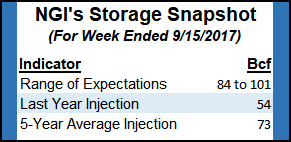Markets | NGI All News Access | NGI Data
NatGas Cash, Futures Trade In Narrow Ranges; October Slips 3 Cents
Physical natural gas for Thursday delivery moved little in Wednesday’s trading as most points outside of Appalachia and the Northeast gave up a few pennies, and gains of a nickel or more at eastern and Appalachian locations nearly offset losses in California. The NGI National Spot Gas Average fell a penny to $2.83.

October futures were confined to a six-cent range as traders looked beyond near-term heat events into more moderate temperatures expected by the middle of next week. At the close October had fallen 2.8 cents to $3.094 and November was lower by 2.6 cents to $3.149. The expired October crude oil finished on a strong note rising 93 cents to $50.41/bbl.
Forecasts for above normal temperatures in major markets had little impact on next-day prices. Wunderground.com predicted New York City’s Wednesday high of 80 would climb to 84 Thursday before easing tgo 79 Friday. The normal high in New York this time of year is 74. Philadelphia’s Wednesday high of 86 was seen holding Thursday before dropping to 82 Friday, 5 degrees above normal. Chicago’s high on Wednesday of 95 was expected to drop to 92 Thursday and 91 Friday, well above the seasonal high of 74.
Gas on Tennessee Zone 6 200 L jumped 28 cents to $2.70 but deliveries to New York City on Transco Zone 6 fell a penny to $3.16. Gas on Tetco M-3 Delivery rose 7 cents to $1.87 and packages on Dominion South climbed 8 cents to $1.78.
Gas at the Chicago Citygate was quoted 3 cents higher at $3.05 and deliveries to the Henry Hub were unchanged at $3.14. Gas on El Paso Permian came in at $2.58, down a penny, and deliveries to Panhandle Eastern changed hands at $2.68, down 3 cents.
At Opal next-day gas traded at $2.66, down 4 cents, and gas at Malin came in 6 cents lower at $2.69. PG&E Citygate was quoted a nickel lower at $3.31 and gas priced at the SoCal Border Average shed 16 cents to $2.72.
The National Weather Service (NWS) in suburban Philadelphia said Tropical Storm Jose will be meandering well offshore through this weekend as it gradually weakens. A weakening Hurricane Maria should parallel the East Coast offshore during early next week, while a cold front approaches from the west during Wednesday, NWS said.
Natural gas bulls counting on exports to Mexico as well as growing shipments of liquefied natural gas (LNG) might want to consider all the new volumes from the northeast basins. “Rover is coming on strong, bringing on huge volumes of Marcellus/Utica natural gas,” noted RBN Energy in a note to clients. “More Northeast pipelines are coming soon. But watch out. Because associated gas from the Permian, SCOOP/STACK and even the Eagle Ford continues to grow. Not to mention the resurgence of the Haynesville.”
Rover Pipeline LLC is wasting no time restarting horizontal directional drilling (HDD) at key sites now that it has the go-ahead from FERC, but the pipeline’s full in-service date could slip to late 1Q2018, Energy Transfer Partners LP (ETP) said Tuesday.
The Federal Energy Regulatory Commission on Monday authorized Rover to complete HDDs at nine sites where the agency had ordered a work-stoppage following an April drilling fluids spill near the pipeline’s crossing of the Tuscarawas River in Stark County, OH.
Traders are divided on market strategy. Walter Zimmermann of United ICAP says “It goes back to my long-standing thesis that there is no more dangerous position than to be short natural gas between Labor Day and Thanksgiving.”
Others are pondering a short position. “All in all, we are maintaining a sideline stance for now but may look to approach the short side later this week should the eight- to 14-day temperature views slip further away from slightly above normal trends,” said Jim Ritterbusch in a Tuesday note to clients.
MDA Weather Services in its morning six- to 10-day report said, “The general ideas remain the same with conditions remaining very warm across the eastern half in the first half before a pattern change occurs late. As ridging builds in the West, temperatures look to moderate to near normal levels in the Midwest and East late while warming above to much above normal along the West Coast.
“There may be some additional cooler risks in the upper Midwest and Northeast late. The East remains the area of lowest confidence with uncertainty regarding the track and timing of Hurricane Maria. Most models keep the storm offshore but impacts on the East cannot be ruled out.”
© 2024 Natural Gas Intelligence. All rights reserved.
ISSN © 1532-1231 | ISSN © 2577-9877 |
